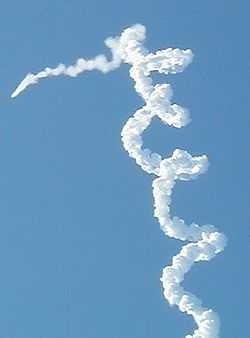Suzaku (satellite)
 | |
| General information | |
|---|---|
| NSSDC ID | 2005-025A |
| Organization | Japan Aerospace Exploration Agency (JAXA) |
| Major contractors | NASA, MIT |
| Launch date | 2005-07-10, 03:30:00 UTC |
| Launch site |
Uchinoura Space Center Uchinoura, Kagoshima, Japan |
| Launch vehicle | M-V-6 |
| Mission length | elapsed: 9 years, 9 months and 20 days |
| Mass | 1706 kg[1] |
| Type of orbit | Circular |
| Orbit height | 550.0 km (inclination 31°) |
| Orbit period | 96 minutes |
| Website | www.jaxa.jp/projects/sat/astro_e2 |
|
The M-V rocket carrying ASTRO-E veering off course after launch on 10 February 2000. | |
| General information | |
|---|---|
| Organization | Institute of Space and Astronautical Science (ISAS) |
| Launch date | 2000-02-10, 01:30:00 UTC |
| Launch site |
Kagoshima Space Center Uchinoura, Kagoshima, Japan |
| Launch vehicle | M-V-4 |
Suzaku (formerly ASTRO-EII) is a Japanese X-ray astronomy satellite launched on 10 July 2005 aboard the M-V-6 rocket. The project was renamed Suzaku after its successful launch after the mythical Vermilion bird of the South.[2]
Just weeks after launch, on 29 July 2005 the first of series of cooling system malfunctions occurred, that ultimately on 8 August 2005 caused the entire reservoir of liquid helium to boil off into space. This effectively shut down the XRS which is the spacecraft's primary instrument. The two other instruments, XIS and HXD, were unaffected by the malfunction, and there are plans to integrate another XRS into the proposed NeXT X-ray observation satellite planned for launch in 2015/2016.
Suzaku instruments
Suzaku is carrying high spectroscopic resolution, very wide energy band instruments for detecting signals ranging from soft X-rays up to gamma-rays (0.3–600 keV). High resolution spectroscopy and wide-band are essential factors to physically investigate high energy astronomical phenomena, such as black holes and supernovae. One such feature, the broad iron K line, may be key to more direct imaging of black holes.
- X-ray Telescope (XRT)
- X-ray Spectrometer (XRS)
- X-ray Imaging Spectrometer (XIS)
- Hard X-ray Detector (HXD)
-
X-ray Telescope (XRT)
-

Hard X-ray Detector (HXD)
-

X-ray Imaging Spectrometer (XIS)
-

X-ray Spectrometer (XRS)
ASTRO-E
Suzaku is a replacement of ASTRO-E which was lost for the failure of launch vehicle. M-V-4 rocket launched on 10 February 2000 at 01:30:00 UTC but experienced a failure 42 seconds later, failed to achieve orbit and crashed with its payload into the ocean.[4]
Results
Suzaku discovered "fossil" light from a supernova remnant.[5]
References
- ↑ Kazuhisa Mitsuda et al. (25 January 2007). "The X-Ray Observatory Suzaku". Publ. Astron. Soc. Japan 59 (SP1): S1–S7. arXiv:astro-ph/0608100. Bibcode:2007PASJ...59....1T. doi:10.1093/pasj/59.1.1. Retrieved 4 October 2010.
- ↑ すざく(朱雀、Suzaku) 命名の理由, JAXA
- ↑ 3.0 3.1 Tadayuki Takahashi et al. (25 January 2007). "Hard X-ray Detector (HXD) on Board Suzaku". Publ. Astron. Soc. Japan 59 (SP1): S23–S33. Retrieved 4 October 2010.
- ↑ Kevin Boyce (2005). "ASTRO-E Launch". NASA Goddard Space Flight Center. Retrieved 2 March 2010.
- ↑ Suzaku Finds "Fossil" Fireballs from Supernovae 12.30.09
Further reading
- Special Issue: First Results from Suzaku. Publications of the Astronomical Society of Japan. Vol. 59, No. SP1. January 30, 2007. Retrieved 4 October 2010.
External links
- X-ray Astronomy Satellite "Suzaku" (ASTRO-EII) (JAXA)
- JAXA/ISAS Suzaku (ASTRO-EII) mission overview
- JAXA/ISAS Suzaku Information for Researchers
- JAXA report presentation of failure analysis of XRS (in Japanese)
- Astronomy Picture of the Day: Launch of the Red Bird
- NASA ASTRO-EII mission description
- NASA/GSFC Suzaku Learning Center
- NASA/GSFC XRS-2 project page
| ||||||||||||||||||||||||||||||||||||||||||
| ||||||||||||||||||||||||||||||||||||||||||||||||||||||||||||||||||||||||||||||||||||||||||||||||||||||||||||||||||||||||||||||||||||||||||||||
| ||||||||||

